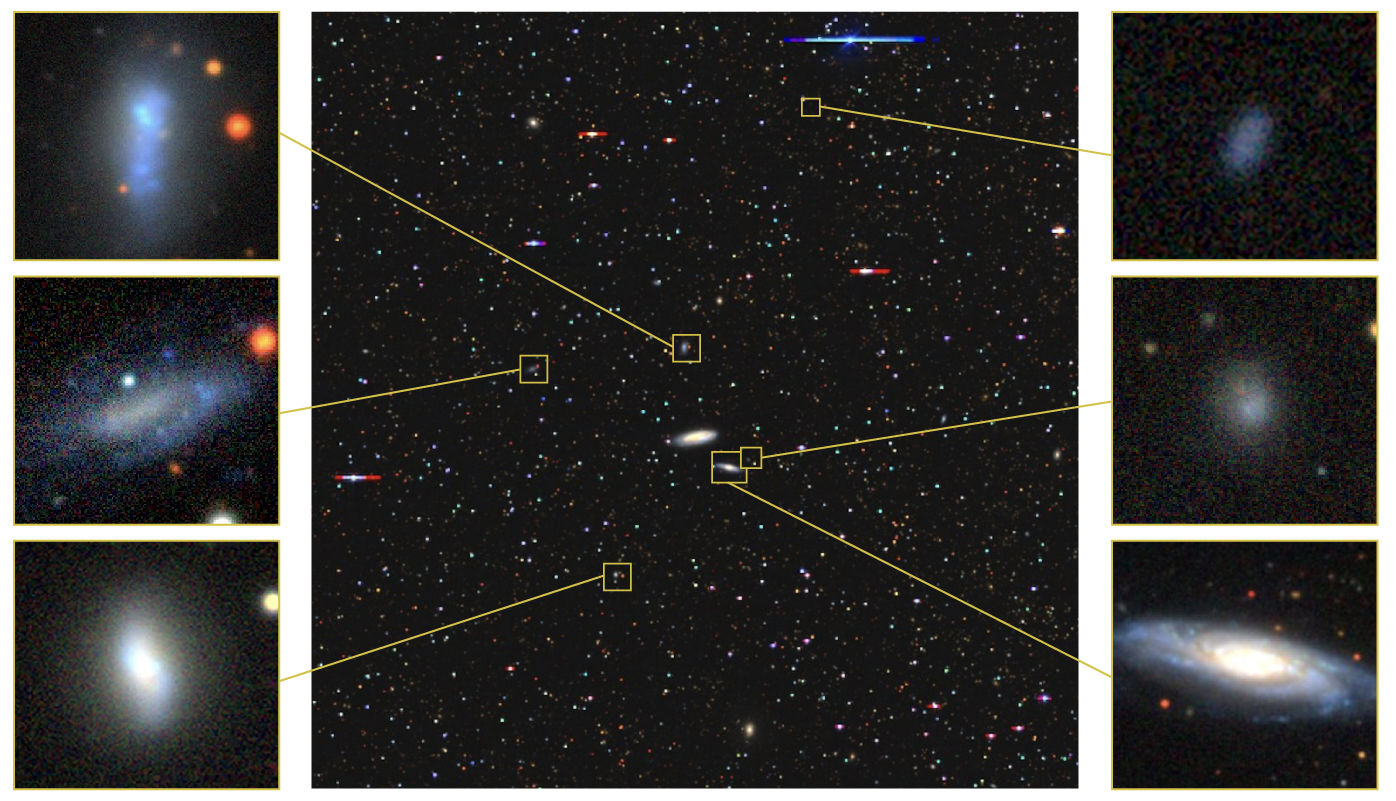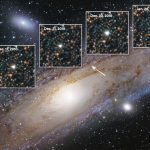Astronomers study the unique traits of our home galaxy to uncover its history and shed light on the enigma of dark matter.
Key Takeaways:
- It turns out the Milky Way’s satellite galaxies are far stranger than scientists once thought.
- Most galaxies like the Milky Way have lively, star-forming satellites — but ours is an exception.
- The unusual properties of the Milky Way’s satellite galaxies may stem from recent acquisitions and its close proximity to Andromeda.
- Examining satellite galaxies provides key insights into dark matter and the processes of galaxy evolution.
In the endless universe, the Milky Way is special—it’s home. From our perch within one of its grand spiral arms, scientists have spent decades studying it, making it the galaxy we know better than any other.
Yet, how typical—or exceptional—is the galaxy that hosts our existence? To what degree does its history align with that of other galaxies across the universe?
Understanding whether the Milky Way is truly unique is essential, as it has long served as a model for studying galaxy formation and evolution. Yet, in a universe populated with countless galaxies, the Milky Way represents only a single case. It raises the question: have we mistaken its peculiarities for defining features, when they may in fact be common across many galaxies?
About a decade ago, Marla Geha of Yale University and Risa Wechsler of Stanford University initiated an ambitious project to tackle this question. Their strategy focused not only on galaxies themselves, but also on their surrounding dwarf satellites—smaller companion galaxies that orbit their larger hosts. Because dwarf galaxies are especially sensitive to their environments, they serve as valuable probes, offering insights into the dark matter halos of their hosts and their evolutionary histories.

Geha and Wechsler named their initiative the SAGA (Satellites Around Galactic Analogs) Survey and embarked on the monumental task of cataloging dwarf galaxies in the distant universe, one at a time, concentrating on those orbiting galaxies analogous to the Milky Way. The faint and diffuse nature of these dwarfs made identifying them—and distinguishing them from background galaxies—a painstaking and meticulous endeavor. By 2017, the team had examined only eight Milky Way analogues. “We knew it was a little bit crazy,” Geha admits. “The idea was that it would be a long, slow process, but it was worth the challenge.”
After a decade-long effort, the team has now cataloged 101 Milky Way analogues and 378 of their satellite galaxies in the distant universe. Their findings indicate that while the Milky Way is not a cosmic anomaly, its satellite galaxies exhibit distinctive characteristics that render it somewhat of an outlier among its peers.
The quest for context

Much of our understanding of faint, diminutive satellite galaxies comes from observations of those orbiting the Milky Way. Its most prominent examples are the Large Magellanic Cloud (LMC) and the Small Magellanic Cloud (SMC), situated approximately 160,000 and 200,000 light-years away in the southern sky, respectively. Both host numerous star-forming regions, such as the Tarantula Nebula in the LMC. In contrast, the Milky Way also possesses over 50 smaller dwarf satellites, none of which exhibit active star formation.
When researchers attempt to model Milky Way-like systems in computer simulations, even the most advanced models struggle to accurately reproduce the galaxy’s swarm of dwarf satellites. This has raised concerns among astronomers about whether the Milky Way—long used as a benchmark—truly represents the broader population of galaxies and their faint companions.
“This has posed a significant challenge in the field for decades,” says Andrew Wetzel of the University of California, Davis, who was not involved with SAGA. “If my sample is small, can it truly represent the broader population?” By cataloging hundreds of Milky Way-like systems beyond our local neighborhood, SAGA has started to provide the crucial statistical context needed,” he adds.
A critical aspect of this work, says Yao-Yuan Mao of the University of Utah—who simulates Milky Way-mass satellite systems for SAGA observations—is that over the past decade, the team has become increasingly proficient at distinguishing satellite galaxies from the vast background of more distant galaxies. This progress has been aided by technological advances. For example, Mao notes that running simulations for 45 Milky Way analogues took about a year in 2015, but the same simulations required only a week last year. “Computational power has increased dramatically,” he observes.

The survey’s first major finding, published in 2017, examined satellite galaxy populations around just eight Milky Way analogues. Even at that early stage, the team began to notice that our galaxy and its satellites were atypical compared to others in the sample. Except for the Magellanic Clouds, the Milky Way’s dwarf satellites have been quenched—having ceased star formation for over a billion years. In contrast, of the 27 dwarf galaxies identified by the SAGA team orbiting other galaxies, all but one remained actively forming stars.
By 2021, the SAGA survey had expanded its catalog to 36 host galaxies, and this trend persisted. In 2024, the team published their latest results in The Astrophysical Journal, increasing the total to just over 100 host galaxies.
These findings indicate that the Milky Way’s satellite population is relatively unusual. Its collection of quenched, inactive dwarf galaxies contrasts sharply with the satellites of other Milky Way-like galaxies in the distant universe, most of which remain actively forming stars.
Moreover, the sample has grown sufficiently large for the team to examine statistical trends, such as the tendency for more massive satellite galaxies to be actively forming stars.
For theorists such as Wetzel, this expanding dataset is invaluable for refining computer simulations in ways that would be impossible using only the Milky Way, he notes. “I’ve long admired the work of the SAGA team — it represents a significant contribution to the field.”

Recent acquisitions
How can we account for the Milky Way’s collection of satellites? According to the SAGA team, the most likely explanation is that while most quenched satellites are older, the star-forming Magellanic Clouds are recent arrivals within the Milky Way’s gravitational influence. Orbital measurements indicate that these galaxies have only recently entered our galaxy’s halo—the vast, invisible cloud of dark matter surrounding the Milky Way—possibly within the last billion years.
“They have not yet experienced the processes that would halt their star formation,” says Ethan Nadler of the University of California, San Diego, a co-author of recent SAGA papers.
Now that the Magellanic Clouds are under the Milky Way’s gravitational influence, the larger host is diminishing their capacity for star formation. Observed in radio wavelengths, these satellite galaxies reveal gas—the essential fuel for star formation—being gradually stripped away by the Milky Way’s immense gravity. Models of this process indicate that in roughly two billion years, after another orbit or so around the Milky Way, the Magellanic Clouds will have lost most, if not all, of their gas, effectively halting new star formation.
“It’s a very intriguing result,” says astrophysicist James Bullock of the University of California, Irvine, who was not involved with SAGA. Rather than being solely determined by a satellite galaxy’s mass, this finding indicates that the process of gas stripping and star-formation quenching is more complex and gradual, he notes. “Perhaps that isn’t surprising, but it is reassuring to confirm.”


It is possible that the Milky Way is unusual in having acquired the majority of its satellite galaxies earlier than comparable galaxies. This early accretion allowed more time for the Milky Way to quench its satellites by stripping away their star-forming gas, leaving only later arrivals, such as the LMC and SMC, still actively forming stars. Meanwhile, the expelled gas contributed to the Milky Way’s halo, providing material that fueled its growth.
Another distinctive factor in the evolution of the Milky Way and its satellites may be the presence of its close neighbor, the Andromeda Galaxy (M31). According to Nadler, the gravitational interaction between these two major galaxies could be affecting their respective satellite systems in ways that differentiate them from other host galaxies in the SAGA survey.
“I believe we now truly understand certain [Milky Way] peculiarities in ways that were previously unclear,” says Geha. Mao adds, “It is rare to gain new, concrete insights about the universe within one’s lifetime—this is truly remarkable.”
Shining light on dark matter
Low-mass satellite galaxies, such as those cataloged by SAGA, serve not only as indicators of a host galaxy’s history but also as valuable tools for investigating one of cosmology’s biggest unresolved questions—the nature of dark matter. Comprising roughly 80 percent of the universe’s mass, dark matter remains elusive, and decades of attempts to detect candidate particles have so far been unsuccessful.

By cataloging quenched satellite galaxies, SAGA enables cosmologists to place constraints on the nature of dark matter and to differentiate between competing theoretical models, as each predicts distinct patterns in satellite galaxy distributions.
For example, in the cold dark matter model, the constituent particles move at velocities far below the speed of light. This type of dark matter is expected to cluster more readily, producing a larger number of satellite galaxies. In contrast, warm dark matter particles travel faster, effectively smoothing the early universe, which results in fewer dark matter halos and, consequently, fewer satellite galaxies.
Cosmologists are now poised to conduct detailed investigations into the particle nature of dark matter using results from the SAGA survey, says Brout. “A decade or two ago, such an endeavor would have been considered impossible.”
The extensive dataset from SAGA is also allowing cosmologists to investigate fundamental questions, such as the timescale over which a satellite galaxy stops forming stars and the proximity to its host galaxy’s center required for this process to occur, adds Bullock.
Observations of individual galaxies provide only a temporal snapshot. By analyzing the distribution of satellites around Milky Way analogues at different distances, cosmologists can begin to construct a timeline and assess whether a single dark matter model can account for satellite galaxies both in the early universe and in the nearby cosmos.
“That’s a big story to tell and if we can tell it with one underlying model of dark matter, that’s a huge win,” says Brout.
The road ahead
Notably, SAGA’s core team has remained intact over the past decade, even though two of their largest observing runs occurred during the challenging COVID-19 pandemic. “It’s a very small team given the scope of what we did,” says Geha, and a tight-knit one.”
She recalls arranging six computer screens in a corner of her living room to continue collecting remote observations from the telescope in Australia, while her son attended kindergarten classes in another corner. During these challenging times, the SAGA team’s weekly check-ins offered vital support and, as she notes, “did a little more than just science.”

Despite the groundbreaking achievements of the SAGA team, their work relied on relatively modest instruments: the 6.5-meter MMT Observatory in Arizona and the 3.9-meter Anglo-Australian Telescope in New South Wales. The latter still uses a spectrograph that has been in operation for over two decades.
“We were essentially using very standard instruments—nothing particularly sophisticated,” says Geha. “The true innovation lay in posing a question that hadn’t been asked before.”
At present, the SAGA team has paused new observations to focus on analyzing the systems already cataloged. Doubling or tripling the number of Milky Way analogues—which could take a decade—would provide limited additional insight, says Geha. To achieve truly transformative results, the sample would need to increase by at least an order of magnitude, a goal that will necessitate next-generation technology.
This transformative leap is expected with the commencement of operations at the Vera C. Rubin Observatory later this year. Capable of imaging nearly the entire southern sky every three nights, Rubin will catalog thousands of ultra-faint satellite galaxies out to distances of 10 billion light-years. Additionally, NASA’s forthcoming Roman Space Telescope will provide detailed imaging of stellar streams in these satellites, enabling astronomers to assess the stage of their quenching processes. Together, these observatories are poised to generate an unprecedented volume of data that could profoundly advance our understanding of galaxy evolution and dark matter.
Like the efforts of the SAGA team, these studies will enable astronomers to gain a deeper understanding of the Milky Way—not merely as our home galaxy, but as one component within a vast cosmic landscape.


